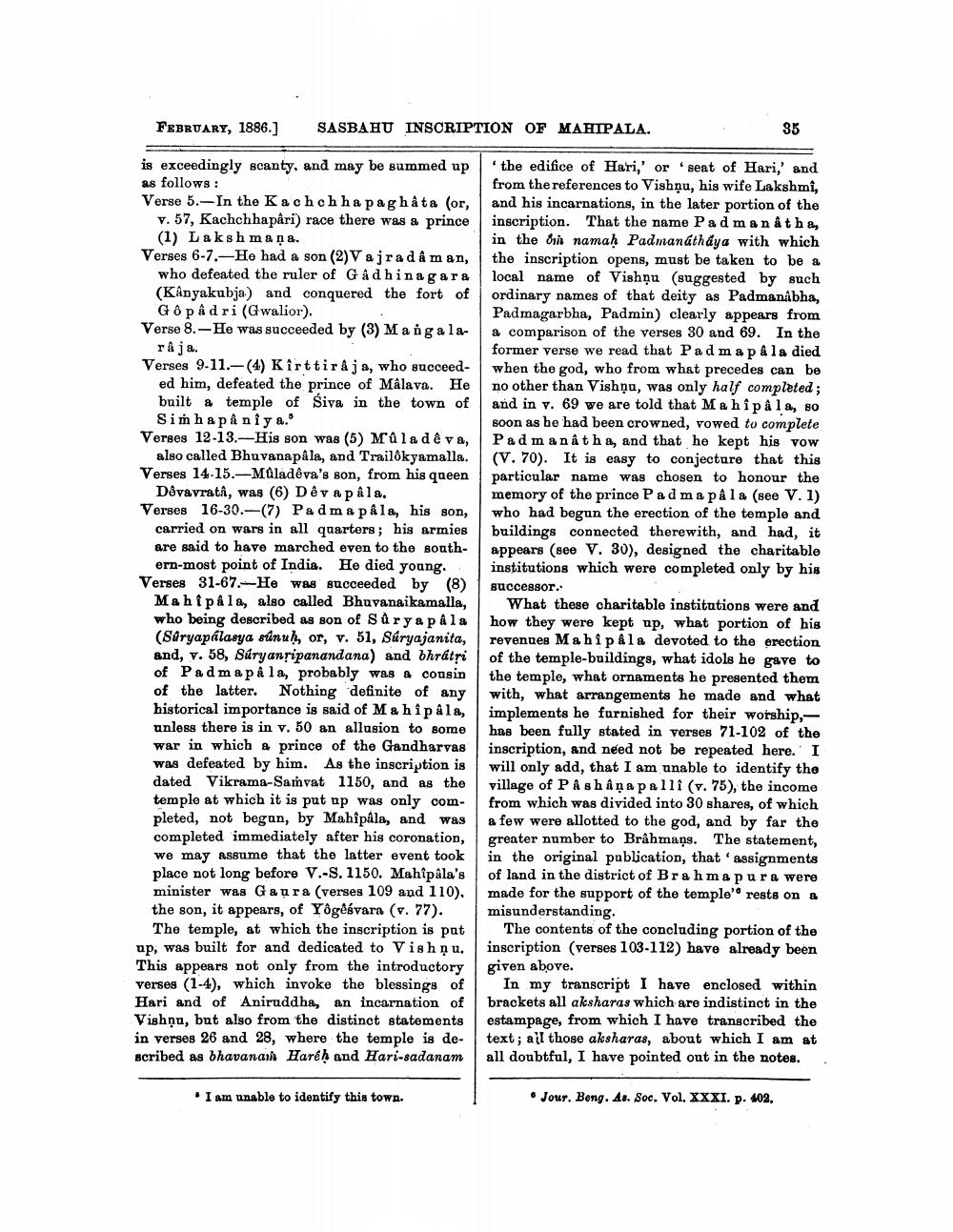________________
FEBRUARY, 1886.]
SASBAHU INSCRIPTION OF MAHIPALA.
35
is exceedingly scanty, and may be summed up as follows: Verse 5.- In the Kachchha pag hâta (or,
v. 57, Kachchhapâri) race there was a prince
(1) Lakshmana. Verses 6-7.-He had a son (2) Vajrad â man,
who defeated the ruler of Gadhinagara (KÂnyakubja) and conquered the fort of
Gopadri (Gwalior). Verse 8. - He was succeeded by (3) M ang ala
råja. Verses 9-11.-(4) Kirttirå ja, who succeed
ed him, defeated the prince of Málava. He built a temple of Siva in the town of
Siñ ha på niya. Verses 12-13.-His son was (5) Múla dê va,
also called Bhuvanapala, and Trailokyamalla. Verses 14-15.- Mladêva's son, from his queen
Dévavrata, was (6) Déva pala. Verses 16-30.-(7) Padma påla, his son,
carried on wars in all quarters; his armies are said to have marched even to the south
ern-most point of India. He died young. Verses 31-67.-He was succeeded by (8)
Mahipala, also called Bhuvanaikamalla, who being described as son of Sarya pala (Suryapalasya sinuh, or, v. 51, Süryajanita, and, v. 58, Süryansipanandana) and bhrát i of Padmap å la, probably was a cousin of the latter. Nothing definite of any historical importance is said of Mahipala, unless there is in v. 50 an allusion to some war in which a prince of the Gandharvas was defeated by him. As the inscription is dated Vikrama-Saṁvat 1150, and as the temple at which it is put up was only completed, not began, by Mahîpâla, and was completed immediately after his coronation, we may assume that the latter event took place not long before V.-S. 1150. Mahipala's minister was Gaura (verses 109 and 110), the son, it appears, of Yogesvara (v. 77).
The temple, at which the inscription is pat up, was built for and dedicated to Vishnu. This appears not only from the introductory verses (1-4), which invoke the blessings of Hari and of Aniruddha, an incarnation of Vishņu, but also from the distinct statements in verses 26 and 28, where the temple is described as bhavanaih Haréḥ and Hari-sadanam
the edifice of Hari,' or seat of Hari,' and from the references to Vishņu, his wife Lakshmi, and his incarnations, in the later portion of the inscription. That the name Padmanatha, in the ori namah Padmanátháya with which the inscription opens, must be taken to be a local name of Vishnu (suggested by such ordinary names of that deity as Padmanabha, Padmagarbha, Padmin) clearly appears from a comparison of the verses 30 and 69. In the former verse we read that Padmap a la died when the god, who from what precedes can be no other than Vishņu, was only half completed; and in v. 69 we are told that Mahipala, so soon as he had been crowned, vowed to complete Padmanatha, and that he kept his vow (V. 70). It is easy to conjecture that this particular name was chosen to honour the memory of the prince Padma pâla (see V.1) who had begun the erection of the temple and buildings connected therewith, and had, it appears (see V. 30), designed the charitable institutions which were completed only by his successor.
What these charitable institutions were and how they were kept up, what portion of his revenues Mahipala devoted to the erection of the temple-buildings, what idols he gave to the temple, what ornaments he presented them with, what arrangements he made and what implements he furnished for their worshiphas been fully stated in verses 71-102 of the inscription, and need not be repeated here. I will only add, that I am unable to identify the village of P Ash âņa palli (v. 75), the income from which was divided into 30 shares, of which a few were allotted to the god, and by far the greater number to Brâhmans. The statement, in the original publication, that assignments of land in the district of Brahmapura were made for the support of the temple rests on a misunderstanding.
The contents of the concluding portion of the inscription (verses 103-112) have already been given above.
In my transcript I have enclosed within brackets all aksharas which are indistinct in the estampage, from which I have transcribed the text; ail those aksharas, about which I am at all doubtful, I have pointed out in the notes.
. I am unable to identify this town.
• Jour. Beng. As. Soc. Vol. XXXI. p. 402.




